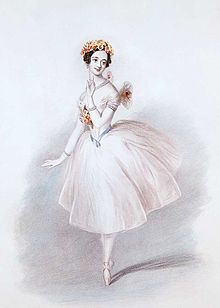History of pointe shoes

Marie Taglioni in the title role of La Sylphide, a ballet danced en pointe for the full length of the work.
The first dancers to rise up on their toes did so with the help of an invention by Charles Didelot in 1795. His "flying machine" lifted dancers upward, allowing them to stand on their toes before leaving the ground. This lightness and ethereal quality was well received by audiences and, as a result, choreographers began to look for ways to incorporate more pointework into their pieces.
As dance progressed into the 19th century, the emphasis on technical skill increased, as did the desire to dance en pointe without the aid of wires. When Marie Taglioni first danced La Sylphide en pointe, her shoes were nothing more than modified satin slippers; the soles were made of leather and the sides and toes were darned to help the shoes hold their shapes. Because the shoes of this period offered no support, dancers would pad their toes for comfort and rely on the strength of their feet and ankles for support.
The next substantially different form of pointe shoe appeared in Italy in the late 19th century. Dancers like Pierina Legnani wore shoes with a sturdy, flat platform at the front end of the shoe, rather than the more sharply pointed toe of earlier models. These shoes also included a box—made of layers of fabric—for containing the toes, and a stiffer, stronger sole. They were constructed without nails and the soles were only stiffened at the toes, making them nearly silent.
The birth of the modern pointe shoe is often attributed to the early 20th century Russian ballerina, Anna Pavlova, who was one of the most famous and influential dancers of her time. Pavlova had particularly high, arched insteps, which left her vulnerable to injury when dancing en pointe. She also had slender, tapered feet, resulting in excessive pressure applied to her big toes. To compensate for this, she would insert toughened leather soles into her shoes for extra support and would flatten and harden the toe area to form a box. While this practice made dancing en pointe easier for her, it was regarded by her peers as "cheating."
Breaking in
Dancers break in, or soften, new pointe shoes in order to improve their fit and thus eliminate the discomfort caused by new shoes. Various methods are employed for breaking in new pointe shoes including deforming them against hard surfaces, striking them with blunt objects, wetting the toe boxes and then wearing them, and heating them to soften the glues, but these method usually shorten a pointe shoe's usable lifetime. Some dancers simply tolerate the discomfort and dance in them until they are naturally broken in.http://en.wikipedia.org/wiki/Point_shoe
No comments:
Post a Comment
Note: Only a member of this blog may post a comment.